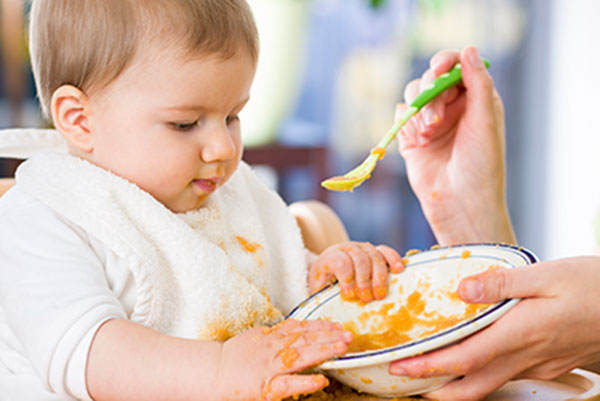You may be thinking about what foods to give your baby, but how you offer those foods is also very important. Both you and your baby have a role in developing healthy eating habits. It isn’t your role to “get” your baby to eat, but rather to help them learn about foods without pressuring them to eat. Let everyone involved in the care of your baby know about the adult’s role and the baby’s role.
As a parent or caregiver, you decide:
- What foods to offer
- When to offer meals and snacks
- Where to offer meals and snacks – Include your baby at family meals so that they can enjoy the social part of eating together and you can be a healthy eating role model for your baby. Babies will learn eating skills best in a happy and relaxed setting, so try to make mealtimes pleasant and not rushed. Avoid distractions during meals and snacks, such as TV, phones, tablets and toys at the table.
- How to offer foods – Give your baby time to learn about foods and feeding themselves, at their own pace
Your baby decides:
- if they want to eat a food
- how much of the food they want to eat

Safety at the Table
|
Learning to eat solid foods takes time. Let your baby explore new foods through their senses of sight, touch, smell and taste.

- let your baby touch their food, even if you’re offering it on a spoon
- let them feed themselves with their fingers as soon as they show interest
- let them be messy – that’s how they learn to feed themselves
- let them try holding the spoon themselves when they show interest
Be patient when offering foods, especially new foods.
- a baby may need to be offered a food 20 or more times before they learn to like it
- if your baby “makes a face” when they try a new food, don’t assume they don’t like it. Making a face may simply be their surprised reaction to the new taste or texture. You may find that they will make a face and then happily open their mouth to try the same food again.
- if your baby does not want to eat a food, wait until another day and offer the same type of food again
- offer different food tastes and textures, and don’t limit the menu to foods you know they’ll eat. Learning to eat and enjoy a variety of foods is an important step in developing healthy eating habits.
Give them chances to learn about foods without pressuring them to eat. Pressuring them will slow down their learning rather than speed it up.
Pressuring them could mean:
- trying to coax a spoonful of food into their mouth rather than waiting for them to show interest and open their mouth willingly
- playing food games such as bringing the spoonful of food towards their mouth saying “here comes the choo-choo train into the station”
Trust your baby to show you how much food they want, if any.
- continue to breastfeed them whenever they show cues for wanting to breastfeed
- respond to their cues when feeding solids
- if your baby is feeding themselves, they will eat what they want and stop when they are satisfied. If they finish what is in their dish, offer them more.

If you are feeding your baby by spoon, offer them more during a feeding when they show cues for wanting more, such as:
- opening their mouth when they see the food
- moving their head towards the food
- reaching towards the food
If you are feeding your baby by spoon, stop feeding when they show cues for having had enough, such as:

- refusing to eat more
- turning their head away
- falling asleep
- playing
- closing their mouth
- covering their mouth with their hand
- shaking their head “no”
- crying
